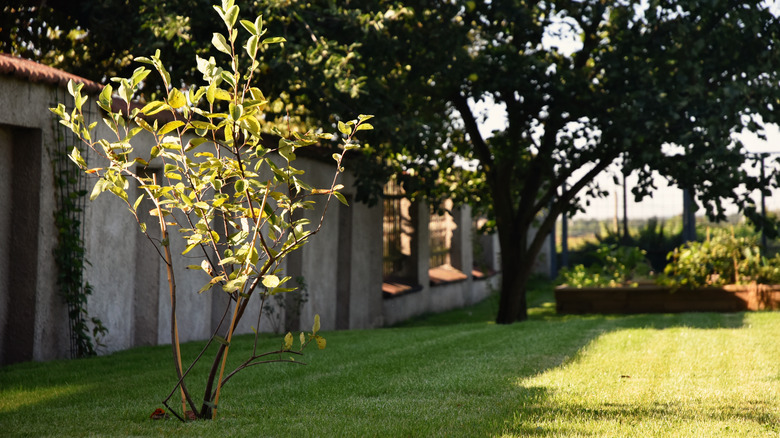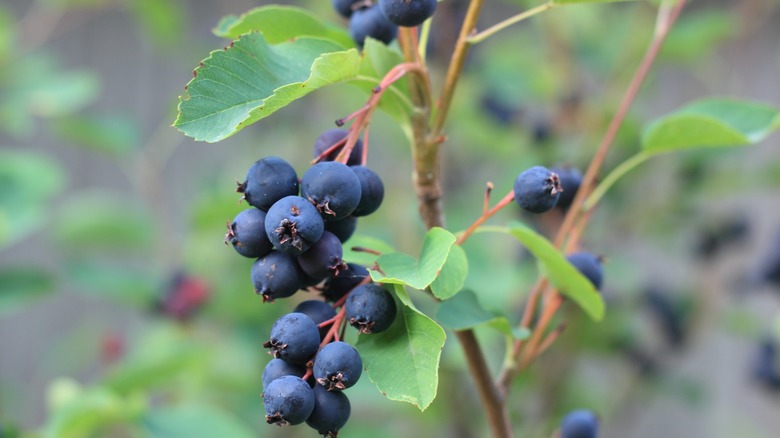The Easy-To-Grow Fruit Tree That Looks Gorgeous In Any Yard
We may receive a commission on purchases made from links.
Gardeners who have tried growing their own fruit know how difficult it can be. From meeting their soil requirements and keeping on top of pruning to maintaining a pest management schedule, there's plenty of care and attention fruit trees require. Fortunately, there's one fruit tree that doesn't make such strenuous demands and is relatively easier to grow. Meet Juneberry (Amelanchier alnifolia).
Named after the time of the year its fruits are harvested, the Juneberry also goes by the names western serviceberry, shadbush, and Saskatoon serviceberry. The Juneberry is a type of serviceberry (Amelanchier spp.) that typically grows to around 18 feet tall, making it ideal for both larger and more compact gardens. For the best quality fruit, choose cultivars like 'Thiessen,' 'Regent,' and 'Pembina.'
Besides, Juneberries can spruce up your garden's aesthetics year-round. They herald spring with clouds of white petals that don't mind late-season frosts. Their summer-borne purple berries — that taste like a sweet blend of blueberries and almonds — look ornate, though you may not get to enjoy the view for long if waxwings and robins have their way. When the temperatures start to cool, their foliage features an exquisite mix of burnished oranges, reds, and yellows, until it's shed, leaving their exfoliating bark as their winter highlight.
Juneberries are easy to grow
Juneberry's unfussiness about soil conditions makes it easy to grow. They thrive in a broad range of pH levels, from 4.8 to 8.0, while tasting similar. These trees also don't mind whether the soil is loamy or sandy, although they do draw the line at soggy soils since they require excellent drainage. Put simply, unless you're dealing with heavy clay soils, you'd rarely need to amend the soil to make it hospitable for these fruit trees.
Serviceberries also do away with the need for a pollinizer tree. Unlike most apple and pear varieties that rely on a pollinating companion to cross-fertilize their flowers for fruit, serviceberries are self-fruitful. Plus, their attraction to nectar-seekers, such as bees and butterflies, assures they'll be effectively pollinated. However, bear in mind that juneberries can take up to three years after transplantation to begin bearing fruit. Also, like many fruit trees, they follow a biennial cycle. This means they'll produce heavily in alternate years. They're also unlikely to throw tantrums if they're planted in a shaded area. However, if you wish to help your fruit trees grow and produce faster, locate them in a site that receives full sun exposure.
Juneberries are easy to maintain... with caveats
If you live in zones 2 to 8, Juneberries are one of the best beginner-friendly trees based on your growing zone. Most varieties can tolerate temperature dips to -40 degrees Fahrenheit, albeit this may vary across cultivars. They're also moderately drought-tolerant. Except for the first year of planting, when they must be watered judiciously for proper root establishment or in exceptionally dry summers, they can do without supplemental irrigation. However, prolonged water deprivation will negatively affect fruit yields.
Juneberries don't attract many pests or diseases either, thereby reducing the need for an extensive pesticide regime. But in poorly draining soils or wet seasons, expect root rot or rusts to take over. You may also need to keep track of the rabbits roaming around in your yard, as they can devour these trees when they're still young. While some may treat this stunning fruit-bearing tree's ability to bring more birds to your yard as an advantage, you may want to harvest a few unripe berries beforehand, or you won't have anything left for yourself. These fruits can continue maturing off the tree, too, and can also be frozen. Another option is to drape bird netting, like Sukh Store's Bird Netting. You may need to trim the foliage during dormancy to open up the air flow and prevent powdery mildew. Maintenance pruning — eliminating crossing branches and suckers — may become necessary to improve plant vigor and fruit production as well as avoid colonization.


